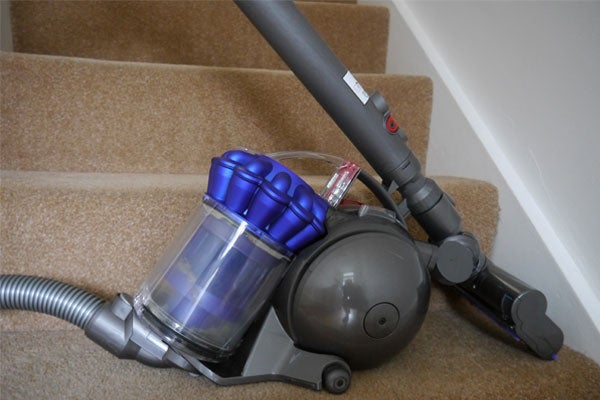Dyson DC49 Review
Dyson DC49
Big suction power in a little body. But can a vacuum really be worth £350?

Sections
- Page 1 Dyson DC49 Review
- Page 2 Performance, Value and Verdict Review
Verdict
Pros
- Dyson digital motor
- Compact, stylish body
- Dyson Ball technology
Cons
- Expensive
- Small dust capacity
- Unweildy hose
Key Specifications
- Review Price: £349.99
- Compact, stylish body
- 0.5 litre dust capacity
- Dyson digital motor
What is the Dyson DC49?
The Dyson DC49 is the company’s latest compact cylinder vacuum cleaner and the first to be powered by the digital motor found within Dyson hand dryers. Originally designed with the ‘small scale, big performance’ needs of the Japanese market in mind, it has been adapted for UK shores as a vacuuming option for apartment or flat dwellers. Although small in size, it will prove a big hit to your wallet, costing a penny shy of £350.
Can a vacuum cleaner ever justify such a lofty price tag or is the Dyson DC49’s compact size its redeeming feature? We take a look to find out.

Dyson DC49 Design
As is often the case with the company’s premium appliances, the Dyson DC49’s design is rather easy on the eye. It is extremely compact, with soft curves and something of a high-end, futuristic air about it. It will land with metallic purple or gold colour elements. The DC49 weighs just 2.7kg, meaning that it can be easily navigated throughout your home. Carrying the vac between floors will not trouble those with a bad back or particularly weak wrists. The whole unit is 30 per cent smaller than last year’s Dyson DC47.
The Dyson DC49 has something of a design based party piece too – its entire footprint is small enough to fit on a single sheet of A4 paper. This is more useful than its sounds. A small footprint makes the vacuum easy to store. It can be bundled into most cupboards, closets or large drawers.
Although the body is simple to store, its hose proves a little more troublesome. Considerably larger than the body and far more unwieldy, much folding and pushing is required to keep it hidden.
The Ball technology at the heart of the Dyson DC49 is the focal point of the vacuum’s performance and design. Although this central steering system puts much of the device’s weight towards its rear end, this unbalance does not affect its manoeuvrability. Compared with a standard, wheel-based cylinder vac, the Dyson DC49 is streaks ahead. Sadly, the premium Dyson DC49 design does not stay pristine for long. Its plastic turbine head and body show a few nicks and scratches after just a handful of uses throughout the home – not great when you consider the price.

Dyson DC49 Features
The Dyson DC49 comes with all manner of attachments letting you tackle every corner, step and crevice of your home. The turbine head – which features carbon fibre bristles to reduce friction of hardwood floors and improve pickup – is the default vacuuming head, but the also DC49 features separate combination tool, stair tool and stubborn dirt brush heads as well as a new flexi crevice tool. A can of Dyson’s own Dyzolv spot cleaner is also included in the box.
Although some of these accessories are more useful than others, the overall result is that the Dyson DC49 is adept at cleaning all areas of your house, car or anywhere else you might want to give a quick vacuum. The turbine head, which will be used for most of your floor-based cleaning needs, has been improved over past models too.
The whole unit has been reduced in size, and an extra-wide brush improves pick-up at the edges of rooms. A change in size without losing suction ability is a welcome improvement. A separate ball-based steering mechanism on the end of this tool further aids easy cleaning.
The Dyson DC49 is limited by its small dust capacity. With just a 0.5 litre bin clipping into the compact body, frequent emptying will be required. Although this vacuum is aimed at those will small flats, this restrictive size could still prove an issue for some. A five metre power cable is amble for most smaller homes letting you clean comfortably from one side of a room to the other without the need to flit between power sockets.

